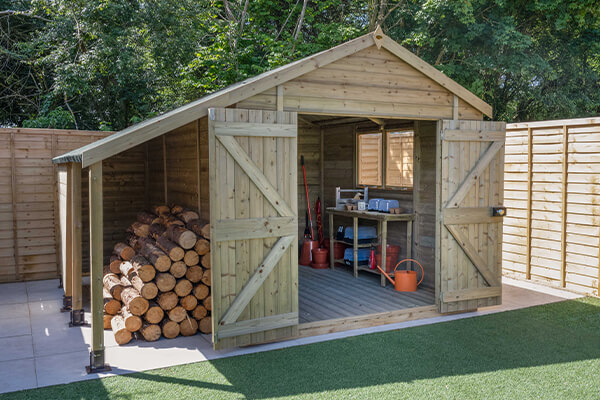Sheds: Beyond Storage - Evolving Roles in Creativity and Community
Discover the rich history and evolving role of sheds, from versatile storage spaces to creative havens and communal retreats that adapt to changing societal needs.
Sheds of Today and Tomorrow: Unveiling Their Multifaceted Significance

A shed is much more than just a humble outdoor structure. It's a place where practicality and creativity intersect. Sheds have been woven into the fabric of human history, and they continue to serve various functions today, from utilitarian storage spaces to charming havens for hobbies and relaxation. This exploration will delve into the multifaceted world of sheds, unveiling the past, present, and future of these unassuming yet fascinating structures.
A Glimpse into History:
To understand the significance of sheds, we must travel back in time. The concept of a shed is as old as human civilization itself. Early humans constructed primitive shelters using natural materials like branches, leaves, and animal hides. These rudimentary structures provided protection from the elements and a safe place to store food and tools. As human society evolved, so did the idea of the shed.
In agrarian societies, the barn became a vital extension of the family home. It served as a shelter for livestock and storage for crops, tools, and equipment. The barn was more than just a structure; it symbolized the heart of a farm, where hard work and sustenance were derived. It embodied the essence of rural life and the bond between humans, animals, and the land.

The Versatility of Sheds:
Sheds are versatile by nature. Their design and purpose can adapt to the needs of the owner. In the modern world, sheds serve a wide array of functions. They are storerooms for garden tools, a shelter for firewood, a workshop for craftsmen, and even a cozy retreat for relaxation.
A garden shed, for instance, is a sanctuary for the green-thumbed gardener. It's a place where seeds are sown, gardening tools are kept, and pots and planters find their winter refuge. It's a small world of horticultural delight, where the fragrance of earth mingles with the scent of flowers in bloom. A garden shed is where gardening knowledge is passed down through generations, where new gardeners learn the secrets of soil and seed from their elders.
The Shed as a Workspace:
Sheds have evolved into workspaces for artisans and craftspeople. The shed's design can be tailored to the unique demands of the trade. Craftsmen work their magic in these spaces, sculpting, painting, welding, or crafting with precision and skill. It's here that imagination meets reality, where raw materials transform into beautiful creations.
Think of the artist's studio, bathed in natural light, where canvases and brushes stand ready. The sculptor's shed, where clay and stone are transformed into works of art. The woodworking shed, alive with the scent of freshly cut wood and the hum of saws. It's within the walls of the shed that the craftsperson's imagination is given free rein, and their passion finds expression.
A Cozy Retreat:
Sheds are not solely spaces of industry; they can also be a haven of leisure and relaxation. The "she shed" is a counterpart to the popular "man cave." It's a tranquil retreat for women, where they can escape from the hustle and bustle of daily life. She sheds often feature comfortable seating, shelves of books, and decorations that reflect the owner's personality and interests. It's a place to unwind, read, paint, or simply find solace.
On the other hand, "man caves" have long been a beloved refuge for men. These sheds are equipped with big-screen televisions, sports memorabilia, and all the elements of comfort and entertainment. It's a retreat for watching games, enjoying hobbies, and spending quality time with friends. The shed's significance here extends beyond the structure itself; it represents a place where individuals can recharge and find inspiration.
Sheds as Communal Spaces:
Sheds can also become communal spaces, playing pivotal roles in society. Consider the "shed quarters" of many organizations. These are designated spaces where volunteers, hobbyists, and community members come together to work on shared projects. Sheds have become the backdrop for skill-sharing, education, and community building.
Community garden sheds, for example, provide a common resource for gardeners. Tools, equipment, and shared knowledge are stored within, and members of the community can borrow or share these resources, fostering a sense of togetherness and sustainability. It's a manifestation of the shed's enduring significance in human social bonds.
Sheds and Sustainability:
The shed has also found a place in the growing movement toward sustainability. Green or eco-sheds are designed with eco-friendly materials and sustainable practices. These sheds often incorporate features like solar panels for energy, rainwater harvesting systems, and even green roofs covered in vegetation. Such sheds are not just functional but environmentally conscious, reflecting an awareness of the need for responsible resource use.
The Future of Sheds:The shed's future is exciting and dynamic. With advances in technology, we may see "smart sheds" equipped with automation, energy efficiency, and digital tools. These sheds could be controlled remotely, adapt to changing weather conditions, and serve as innovative workspaces for various industries. As the world becomes more connected, the shed evolves as well, embracing the era of the Internet of Things (IoT).
In the world of sustainable architecture, we can anticipate a surge in "tiny sheds" designed to minimize the carbon footprint. These compact structures may serve as mini-homes, guest houses, or offices, providing efficient and sustainable living solutions. As urbanization and environmental awareness continue to rise, these tiny sheds offer a glimpse into the future of eco-friendly living.
why it is called a shad?: the term "shed" has its origins in Old English, where it was initially used to describe a place of separation or division. Over time, it evolved to refer to a simple, single-room structure, often with a sloped roof, that was used for various purposes, including storage, shelter, or work. The name likely stuck because these structures were typically smaller and simpler than other buildings, and they were often used to "shed" or store items or provide shelter from the elements. The name "shed" captured the essence of these unassuming, practical structures, and it has persisted to describe a wide variety of similar buildings throughout history.
The difference between a hut and a shed?:
- Construction Material:
- Sheds: Sheds are typically constructed using a variety of materials, such as wood, metal, or plastic. The choice of material depends on the intended use and the local climate.
- Huts: Huts are often associated with more traditional or natural construction materials, such as wood, thatch, bamboo, or mud. They are frequently built using locally available resources.
- Roof Design:
- Sheds: Sheds typically have sloped or gabled roofs, which allow for efficient rainwater runoff. The roof design can vary based on the specific use of the shed.
- Huts: Huts often have conical or domed roofs, especially in traditional or indigenous designs. These roofs are well-suited for shedding rain and often have thatch or palm leaves for roofing material.
- Intended Use:
- Sheds: Sheds are versatile and can serve a wide range of purposes, such as storage, workshops, gardening, or as functional additions to residential properties.
- Huts: Huts are often associated with providing shelter for people. They can serve as dwellings, traditional housing, or temporary shelters, especially in rural or less developed areas.
- Cultural and Regional Variations:
- Sheds: Sheds are commonly found in a variety of cultures and regions, but they are more common in industrialized or urbanized areas.
- Huts: Huts are often associated with traditional or indigenous cultures and are frequently found in rural or less developed regions.
- Appearance and Aesthetics:
- Sheds: Sheds may have a more utilitarian and functional appearance, although they can also be designed with aesthetics in mind, especially when used as garden sheds or backyard structures.
- Huts: Huts often have a more rustic and traditional appearance, with designs that reflect local culture and building traditions.
in summary a shed is a small, single-room structure typically used for storage, as a workshop, or for various other practical purposes. It can be constructed from materials like wood, metal, or plastic and often features a sloped roof for rainwater runoff. Sheds are versatile and can serve a wide range of functions in both urban and rural settings.



